Geothermal energy
| Energy: A Historical Perspective and 21st Century Forecast | |
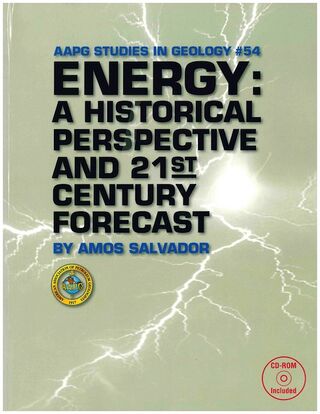
| |
| Series | Studies in Geology |
|---|---|
| Chapter | Sources of Energy |
| Author | Dr. Amos Salvador |
| Link | Web page |
| PDF file (requires access) | |
Geothermal resources throughout the world have been used for various purposes for centuries. Hot springs were used for bathing and medicinal purposes in ancient Greece, Rome, Babylonia, and Japan, among many other places. Medicinal spas are still popular resorts throughout the world.
Geothermal hot water has been used directly for space and district heating, for aquacultural and agricultural purposes, and for a variety of industrial applications. Much of Reykjavik, the capital of Iceland, located on the Mid-Atlantic spreading ridge, has been heated since the 1930s with geothermal hot water. Many other countries, such as Japan, New Zealand, Hungary, and the United States (Boise, Idaho, and Klamath Falls, Oregon, for example), use geothermal energy for space heating. Such direct use of geothermal energy, in fact, is possible virtually anywhere in the world.
Direct use of geothermal energy, although considerable now and possibly a sizable source of heat in the future, is not included in the following discussion. The discussion is restricted to the use of geothermal energy for the generation of electricity, which was accomplished for the first time at Larderello, Italy, in 1904. Although the first generator produced only enough electricity for five light bulbs, the Larderello geothermal field has been generating electricity on a commercial scale since 1913.
Elsewhere, generation of electricity from geothermal sources began in New Zealand in 1958 and a year later in Mexico. In the United States, it started in 1960 at The Geysers field in California. Japan followed in 1966 and the former Soviet Union in 1967. Many other countries began geothermal electricity generation shortly thereafter. The Geysers is, at present, the largest geothermal electric power installation in the world.
Geothermal energy, in the broadest sense, is the natural heat of the Earth. Temperatures in the Earth rise at different rates in different regions with increasing depth (geothermal gradient). Most of this heat, however, is far too diffuse ever to be recovered economically. Consequently, most of the heat in the Earth cannot be considered a potential economic energy source, unless it is concentrated enough and hot enough when close to the Earth's surface.
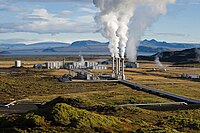
Economically significant concentrations of geothermal energy occur now where high temperatures (40° to more than 380°C; 104° to more than 716°F) are found in porous and permeable rocks at shallow depths (less than 3000 m; about 10,000 ft). The geothermal energy is stored in both the solid rock and the water or steam-filling pores and fractures. The steam or hot water are used mainly as the fuel for the operation of electricity-generating turbines or for space heating.
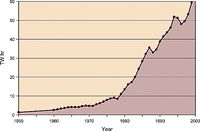
There are, therefore, three main requirements for the commercial development of geothermal resources: shallow high temperatures, rocks with good permeability, and sufficient volumes of water. At present, there are two major types of commercial geothermal systems for the generation of electricity: water-dominated (hot-water) systems and vapor-dominated (dry-steam) systems. Hot-water systems are much more common than dry-steam systems, of which only four commercial fields are known at present: The Geysers, 115 km (70 mi) north of San Francisco, California; Larderello, in central Italy; Matsukawa in Japan; and possibly Kawah Kamojang in western Java, Indonesia.
A third type, the hot-dry-rock system (HDR), is designed to recover heat from impermeable hot dry rocks at depths of 1500–2000 m (5000–6500 ft) by drilling two closely located wells into them, artificially fracturing the rocks, and injecting water through one well and recovering it from the other after having been heated by the hot rocks. Experimental attempts to recover geothermal heat in this way have so far failed to demonstrate that hot-dry-rock systems are economically viable. In these systems, energy recharge is only by thermal conduction and, because of the slowness of this process, their geothermal energy should be considered exhaustible.[2] Some experts, however, believe that the long-range future of geothermal energy may depend on HDR systems becoming a technological and economic reality.[3]
The occurrence of favorable geothermal conditions for the commercial generation of electricity is limited geographically and geologically. Regions with geothermal potential are mainly located along belts of active magmatism, mountain building, and faulting principally localized along the boundaries of major Earth crustal plates, belts where either new material from the mantle is being added to the crust (spreading ridges) or where crustal material is being dragged downward and consumed in the mantle (subduction zones). In both cases, molten rock is generated and moved upward into the crust and near the surface of the Earth. Geothermal energy for the commercial generation of electricity is absent in the stable continental shields, which are characterized by lower-than-average geothermal gradient.
Sources of internal heat
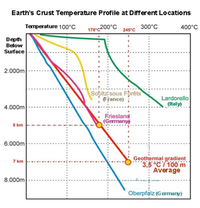
Remaining heat and radioactive heat
- Geothermal Gradient is called to the variation of temperatura according to depth rocks are.It is read in Celcius or Farenheit grades by the unit of vertical distance.The gradient in our planet is quite variable and it depends on different causes.
- Surface Heat Flow is the heat that continuosly comes up to the surface.It is read in Joules per Second.It is estimated that the average is 42x1012J/seg and has two different sources:
- Remaining heat release:It is 34x1012J/seg. It comes florm the Mantle and the Nucleus and it is the remaining heat after the formation of the planet.
- Radioactive heat release:It is 8x1012 J/seg .It comes from the Crust and it is produced by the fission of radiactive isotopes.
See Figure 1
Igneos phenomena
In certain regions the geotermal gradient can be increased considerably due to magmatic process (Figure 2).Most of the áreas of goethermal interest are situated in volcanic regions.In many places of our planet,hydrotermal evidence can be seen on the surface provided that geologial conditions are favourable.
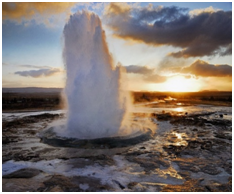
Plate Tectonics and heat distribution
The unequal distribution of the heat inside the Earth is what causes the movement of tectonic plates and all of endogenous phenomena (Figure 3).All the áreas having higher heat flows are related to plate borders or Hot Spots.These higher flows are related,besides,to other parameters such as conrtical width,rocks thermic conductivity ,permeability, fluids ´ presence.etc.
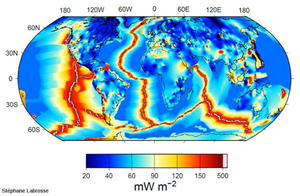
Kinds of Geothermal Deposits
Very low temperature deposits (T<30ºC)
- It is generally considered that temperature seasonal variations are percived only over the first 10 meters f the soil. After that there is a interval where the temperature is almost constant and it is considered that below 20 meters, the temperature increases three grades every 100 meters.Therefore ,all the planet is a source of geotermal resources of low temperature.These resources have domestic use.
Low temperature fields (30ºC<T<90ºC)
- They are found in sedimentary basins with normal o hightly superior geotermal gradient.The sole condition is the existence of one or more aquifer horizons in adequate depths.Ej Paris Basin (France) ;Boise (EEUU) (Figure 4).
 Figure 4: Goethermal heating district. City of Boise. EEUU. [4].
Figure 4: Goethermal heating district. City of Boise. EEUU. [4].
Medium temperature deposits (90ºC<T<150ºC)
- They are foundin various places of our planet.They usually belong to áreas with specific geologic characteristics such as áreas of thin crust,higher concentration of radioactive isotopes or áreas close to or near igneous bodies.They can also be found over regions with higher gradient but a lower depth.They generally need an igneous intrusión and it is usual that,in this kind of field,water comes up to the surface forming hot springs.
High temperature fields (T>150ºC)
- These deposits are found in áreas of higher igneous activity.They are related to extremely high gradients, corresponding to global tectonic process.They occur in plate borders, cortical thinnes áreas or Hot Spots. They need an igneous source an aquifer and a impermeable layer to keep up pressure. In many cases there is surface evidence suchs as geysers and fumaroles,
 Simplified diagram of a geotermal power plant. [5].
Simplified diagram of a geotermal power plant. [5].
Hot dry Rock Deposits or Geotermal Stimulated Systems
- They are a kind of high temperature field but in wich the content off water and permeability is improved artificially by means of hydraulic fracture (the same method used in unconventional hydrocarbons resources).An example of this is the Soultz-sous-Forets Geothermal Field in France,where the heat source is a fractured granitic pluton
Extraction and uses
A geotermal central Works similarly to a thermic one :The only variation is the way to heat water.Water vapour at high temperaturas (up to 600ºC) is directed from the inside the earth to the central, allowing the evaporation of water present in different pipes surrounding the boiler. The water vapour reches higher pressure,thus it is used to move a turbine connected to the generator .When the turbine turns,electricity is produced, wich goes from the generator to the transformers. These increase the tensión of electricty, to transpor this energy along electrical network to home users.The refrigeration system allows to condenses the water vapour,so that can be used again.
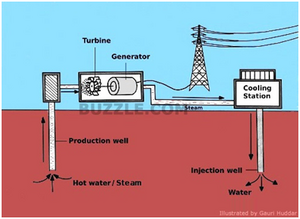
Sources
- Guia de la Energia Geotermica;2008;Fundacion de la Energia de la comunidad de Madridhttp://www.fenercom.com/pages/publicaciones/publicacion.php?id=50
- British Geological Survey pagehttp://www.bgs.ac.uk/research/energy/geothermal/
- Página del Instituto cartográfico y Geológico de Cataluña http://www.igc.cat/web/es/subsol_geotermia_jaciment.html
- “EnergiaGeotermica”.Publicacion de la Secretaria de Energia de la República Argentina. http://www.energia.gov.ar/contenidos/archivos/publicaciones/libro_energia_geotermica.pdf
See also
References
- ↑ Salvador, A., 2005, Energy-A historical perspective and 21st century forecast: AAPG Studies in Geology 54, 208 p.
- ↑ Stefansson, V., 2000, The renewability of geothermal energy: Proceedings of the World Geothermal Congress 2000 (Japan), p. 883-888.
- ↑ World Energy Council, 2001, Survey of energy resources.